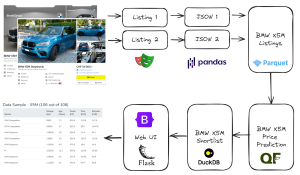In Snowflake, databases are similar to virtual hard drives where you store data, while warehouses are the virtual compute resources you use to run analytical queries.
In today’s data-driven world, having a robust and efficient data management system is crucial for any organization looking to gain valuable insights from their data.
One such system that has been gaining traction in recent years is Snowflake, a cloud-based data warehousing platform that provides a simple and flexible way to store, query, and analyze data.
We will be diving into the key concepts of Snowflake, specifically focusing on the differences between databases and warehouses and how they can be leveraged to maximize data insights.
Snowflake Databases
“All data in Snowflake is maintained in databases. Each database consists of one or more schemas, which are logical groupings of database objects, such as tables and views.” –Snowflake Docs
A Snowflake database is a container for one or more virtual warehouses, which are the compute resources used to query data stored in the database.
A database also contains one or more “schemas”, which are collections of tables, views and other database objects.
This allows for a logical organization of data within a Snowflake account, making it easy to manage and access large amounts of data.
Snowflake Warehouses
“A virtual warehouse is a cluster of compute resources. A warehouse is needed to execute certain types of SQL statements because it provides resources such as CPU, memory, and local storage.” –Snowflake Docs
Now, let’s talk about warehouses. A Snowflake warehouse is a virtual compute cluster that you can use to query and manipulate data stored in a database.
You can create one or more warehouses within a database, and you can configure each warehouse with different compute resources, such as the number of virtual CPUs and amount of memory.
This allows for granular control over the resources used for different types of queries, ensuring that your data is being queried efficiently and cost-effectively.
Separation of Compute and Storage
One of the key benefits of Snowflake is the ability to scale compute resources on-demand.
This means that if you have a particularly large query that needs more resources, you can simply increase the number of virtual CPUs or amount of memory for that specific warehouse, and then scale them back down when the query is complete.
This eliminates the need for over provisioning resources, resulting in cost savings for the organization.
In addition, Snowflake also provides a variety of features that make it easy to gain insights from your data. These features include a SQL editor, a web-based interface, and integration with popular data visualization tools such as Tableau and Looker.
This allows for seamless data exploration, making it easy for business users to gain insights from their data without the need for technical expertise.
Conclusion
In conclusion, Snowflake provides a powerful and flexible solution for managing and analyzing data.
By understanding the differences between databases and warehouses and leveraging the on-demand scaling and data exploration features, organizations can maximize their data insights and drive business decisions.




